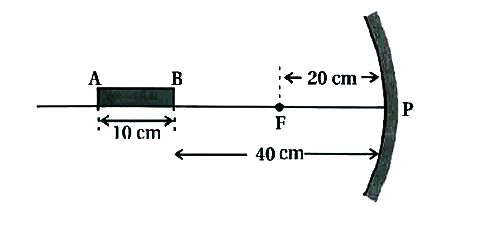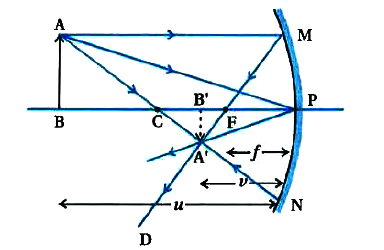Answer the following questions:
(d) Why must both the objective and the eyepiece of a compound microscope have short focal lengths? Solution in Gujrati
The angular magnification of eye-piece is
(25fe+1) . If fe is smaller then angular magnification increases.
⇒ Also, magnifcation of objective is
v0|u0|=1(|u0|/f0)−1 where f0 is less than |u0|, then it is large . To observe the very nearer objects, microscope is use. Hence, |u0| is small but f0 is smaller.
Topper's Solved these Questions
- BOOK - KUMAR PRAKASHANCHAPTER - RAY OPTICS AND OPTICAL INSTRUMENTSEXERCISE - SECTION-B (NUMERICALS)(NUMERICAL FROM .DARPAN. BASED ON TEXTBOOK )12videos
RAY OPTICS AND OPTICAL INSTRUMENTS
- BOOK - KUMAR PRAKASHANCHAPTER - RAY OPTICS AND OPTICAL INSTRUMENTSEXERCISE - SECTION-C (NCERT EXEMPLAR SOLUTION) (MULTIPLE CHOICE QUESTIONS (MCQs))16videos
RAY OPTICS AND OPTICAL INSTRUMENTS
- BOOK - KUMAR PRAKASHANCHAPTER - RAY OPTICS AND OPTICAL INSTRUMENTSEXERCISE - SECTION-B (NUMERICALS)(NUMERICAL FROM TEXTUAL ILLUSTRATIONS)17videos
RAY OPTICS AND OPTICAL INSTRUMENTS
- BOOK - KUMAR PRAKASHANCHAPTER - MOVING CHARGES AND MAGNETISMEXERCISE - SECTION D (MCQs ASKED IN COMPETITIVE EXAMS)34videos
MOVING CHARGES AND MAGNETISM
- BOOK - KUMAR PRAKASHANCHAPTER - SAMPLE QUESTION PAPER EXERCISE - PART-B SECTION-C5videos
SAMPLE QUESTION PAPER
Similar Questions
As shown in the figure, a thin rod AB of length 10 cm is placed on the principal axis of a concave mirror such that it.s end B is at a distance of 40 cm from the mirror. If the focal length of the mirror is 20 cm, find the length of the image of the rod
 01:08View Solution
01:08View SolutionA ray of light incident at an angle θ on a refracting face of a prism emerges from the other face normally. If the angle of the prism is 5∘ and the prism is made of a material of refractive index 1.5, the angle of incidence is
01:38View SolutionSuppose that the lower half of the concave mirror.s reflecting surface as shown in figure is covered with an opaque (non-reflective) material. What effect will this have on the image of an object placed in front of the mirror ?
 04:31View Solution
04:31View SolutionElectric charge Q having mass M moves on a circular path of radius R with velocity →v, perpendicular to uniform magnetic field B. When a particle completes one revolution, work done by the field is _______
03:45View SolutionTwo charges –q and +q are located at points (0, 0, –a) and (0, 0, a), respectively.
(a) What is the electrostatic potential at the points (0, 0, z) and (x, y, 0) ?
(b) Obtain the dependence of potential on the distance r of a point from the origin when r/a>>1 .
(c) How much work is done in moving a small test charge from the point (5,0,0) to (–7,0,0) along the x-axis? Does the answer change if the path of the test charge between the same points is not along the x-axis?View SolutionObjective of a compound microscope should have small focal length. Why ?
02:09View Solutiond) Why must both the objective and the eyepiece of a compound microscope have short focal lengths ?
View SolutionTo increase magnification of a compound microscope , the objective and the eyepiece of …. Focal lengths and the microscope tube of ….. Length are to be taken [fill in the blanks] .
01:55View SolutionDefine the magnifying power of a compound microscope when the final image is formed at infinity . Why must both the objective and the eyepiece of a compound microscope has short focal lengths ? Explain.
04:25View SolutionDefine the magnifying power of a compound microscope when thefinal image is formed at infinity. Why must both the objective and the eyepiece of a compound microscope has short focal lengths? Explain.
03:18View SolutionWhy must both the objective and the eyepiece of a compound microscope have short focal lengths?
View SolutionAnswer the following questions:
(d) Why must both the objective and the eyepiece of a compound microscope have short focal lengths?View SolutionAnswer the following questions:
(d) Why must both the objective and the eyepiece of a compound microscope have short focal lengths?04:35View Solution(i) Draw a neat labelled ray diagram of a compound microscope. Explain briefly its working. (ii) Why must both the objective and the eye-piece of a compound microscope have short focal lengths ?
03:35View SolutionAnswer the following questions:
(d) Why must both the objective and the eyepiece of a compound microscope have short focal lengths?03:28View SolutionDefine the magnifying power of a compound microscope when the final image is formed at infinity. Why must both the objective and the eyepiece of a compound microscope has short focal lengths ? Explain.
View Solution

